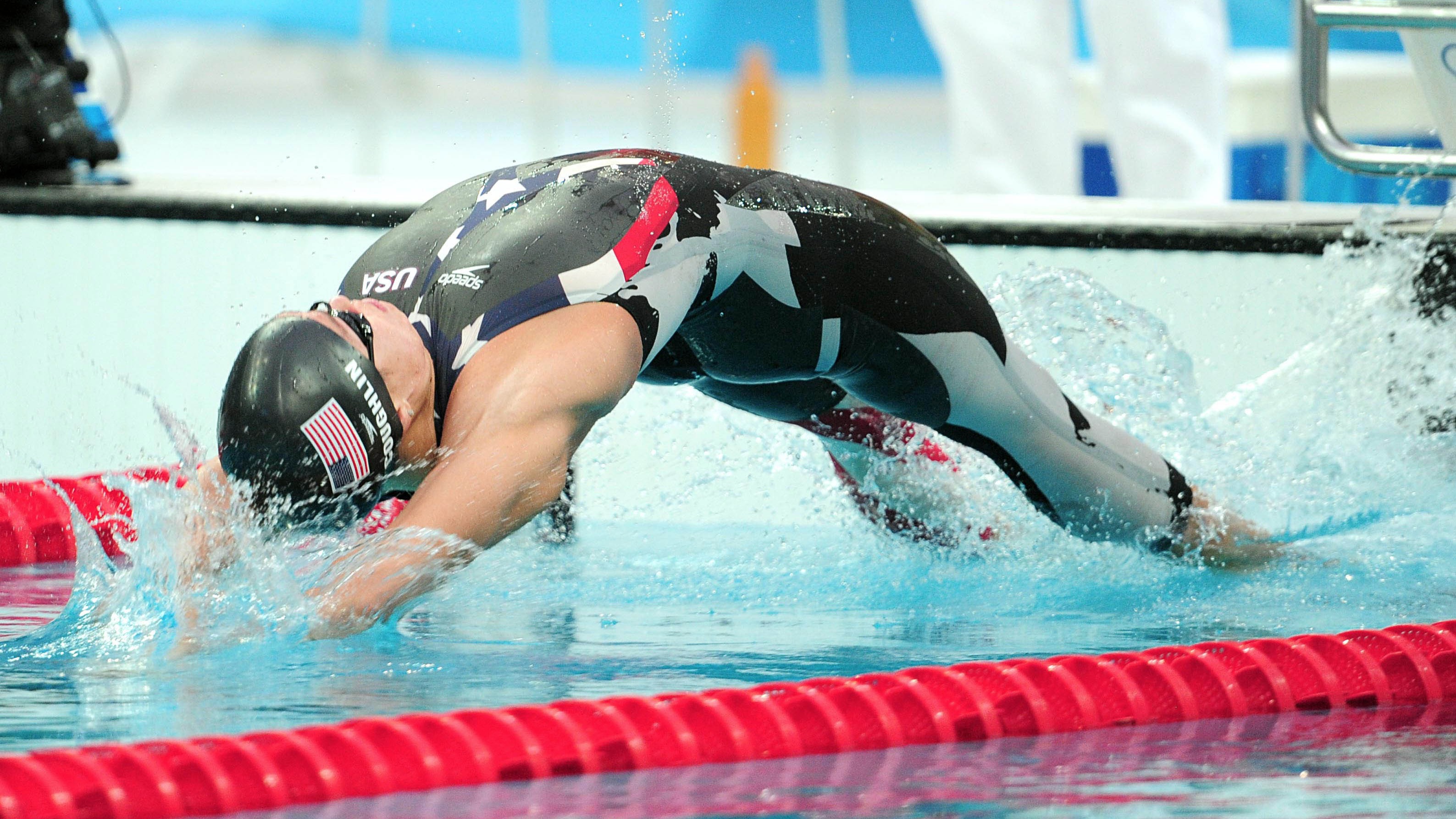A History Of Women In Olympic Swimming
A History Of Women In Olympic Swimming
Temarie Tomley, swimmer for the University of Alabama, breaks down the history of women's swimming in the Olympics.

The 1920 Olympics in Antwerp, Belgium, were the first to include American women in swimming. There were three events they swam: 100m free, 300m free, and 4x100m free relay. The first American gold was won by Ethelda Bleibtrey in the 100m free with a time of 1:13.6. She went on to win the 300m free and also led the U.S. women's relay to victory. But she wasn't the only successful woman from the United States; the top three women in the 100m free and 300m free were all Americans as well.
Although this success was great for the country's medal count, U.S. women were actually late to the game. Women were first included in the Olympics in 1912, but American women were not allowed to attend until the 1920 Olympics due to the long skirt rule in the 1910s that required women to wear full length skirts and not show any leg.
A lot has changed since then. In 2016, American Simone Manuel tied with Penny Oleksiak from Canada to win gold in the 100m free with a blistering time of 52.70. So what has led women in the 100m free to drop a whopping 21 seconds, compared to 13 seconds in the men's race, in just under 100 years?

Pool Improvements
The pool in the 1920 Olympics was outside, dark, and cold. It was just open water, with no flags, lanes, or blocks. They used a gun to start the race, and the swimmers simply dove off the side of the pool into the water. There were also no volunteers or media to watch the events.
The first equipment to be used in the sport of swimming was the addition of lane dividers made of cork and lines that ran along the bottom of the pools in the 1924 Olympics. This improvement kept swimmers swimming in a straight line and prevented them from running into each other during the race. Later, starting blocks, flags, touchpads, and timing systems were added into the sport.
Along with all of these new innovations to pools, many have been redesigned, standardized, and improved since then. Our lane lines are now made of plastic floating disks; blocks have wider platforms, adjustable fins, and a recent backstroke start addition. Our timing systems have only gotten more precise as well. The actual construction of pools, swimming facilities, and the locker rooms have all become way more advanced since the 1920s.
Pools now are built in massive indoor facilities, with gutters, air filtration, chlorine regulation, increased depth, and sometimes as many as 10 large lanes. Along with a 50m competition pool, there are multiple pools available for warm-up and warm-down. Although these improvements are contributing factors that helped increase female speed, they are also aided men's times as well.

Suits and Equipment
Swimsuits have had a long road of development in the sport. Speedo launched in 1910 and has since grown into the leading competitive swimwear brand in swimming.
In the 1920s, it was hard for women to go swimming due to many controversies over the suit they were allowed to wear. Women were allowed to wear tank suits that were androgynous and resembled men's suits. They looked similar to our speed suits today but way baggier and made from material that created a lot of drag. The suits were originally made of wool or thick material and mainly just black in color. Swimwear modesty was very important during this time and women could be ridiculed for wearing a suit that was too tight or revealing. This would make training hard because what women wore was more important than their training itself.
This idea started to change in the 1930s.
Being healthy and exercising started to become more important, and modesty started to take a backseat. Female swimwear slowly changed over the years to cover less skin (the premise being that less material meant less drag) and become tighter.
In the 1976 Olympics, teams were sporting suits that were more colorful and patterned. They were also tighter and featured racerback and open-back shapes. They came up a little bit on the hips and were made of thinner material compared to today's suits.
This style became more refined in the 1984 Olympics. These suits were made of tight, stretchy lycra that fit like a second skin.

In 1992, suits were made of nylon, were form fitting, had 15 percent less drag, and included more designs.
The biggest change occurred at the 2000 Olympics. Speedo introduced the fastskin body suit that covered the entire leg and arm. They were made of knitted biometric material.
In 2008, another big jump was made with the Speedo LZR suits, which had polyurethane panels that NASA helped to develop. These Olympics were the fastest yet, with 25 world records broken, 23 of which were done by swimmers wearing the new suit. The suits were later banned from competition due to the increased flotation ability that the panels on the suit provided to the swimmer.

By 2012, a modified version was created that went only to the knee with a tank top strap top to the Speedo tech suit. The change in suit affected times minimally, as records and fast swims still occurred at these Olympics at a normal rate. The drastic suit change definitely contributed to the improvements women have seen in time the last 100 years. However, that isn't the only factor, because men's suit were changing as well.
Feminine Hygiene Products
There are biological differences between men and women. Earle Haas invented the tampon in 1929, and it hit stores in the mid-'30s as Tampax. The use of tampons didn't become widely used until World War II, due to women becoming more active and exercising more. This meant that up until that point, women were out of the pool one week per month due to nature.
Swim training wasn't consistent until almost 20 years after women were able to compete in the Olympics. Taking a week off every month is unheard of now for female athletes. The tampon was a simple invention that forever changed women in sports and helped exponentially to improve the times of female swimmers throughout this past century.
Everything Else
With every new invention that was brought into swimming: strokes, suits, equipment pool technology, etc… swimmers perfected it. Whether it was technique for a stroke or training, coaches and swimmers alike found every way to make it better and improve. Starts off the blocks became more effective. Training got harder, longer, and more specific. Turns were made into somersaults, and female athletes became stronger with weightlifting and nutritional programs.
On top of all that, prehab, rehab, and therapy programs came into use and were utilized more in preventing injury or bringing athletes back from it and staying in the sport longer. To continue, media and spectators brought a whole new energy to the sport that created electricity in the pool. Everything started to come together like puzzle pieces.
It is amazing what swimming's female predecessors have accomplished and what women continue to accomplish today in the pool. Women are now going faster and faster thanks to technology innovations, training changes, and today's society. There are women swimming at the Olympics from age 13 to age 40-plus and women who continue to compete after having children and starting families. I am proud and amazed at the history of women in swimming, humbled by my experience today, and am excited for the future achievements of women in this sport.

Fun Facts
- Scotland held the world's first women's swimming championship in 1892
- Men started competing in swimming at the Olympics in 1896
- 1916: AAU recognizes a swimming national championship for women, which is the first sport to do so
- 1923: The first women's intercollegiate swim meet between Radcliffe College and Sargent College
- Women only swam freestyle in the Olympics until 1924, when backstroke and breaststroke were added to the lineup
- 1952: FINA adds butterfly and medley relay events to both men and women competitive events
- 1960s: Swimming goggles introduced, but many didn't wear them until the '70s (Ex: Mark Spitz)
- It wasn't until 1976 that men and women swam the same number events (13); today 17 events are swum by men and women
---
FloSwimming's best content, delivered to your inbox!
Don't miss breaking news, feature stories, event updates, and more. Sign up for the FloSwimming mailing list today.